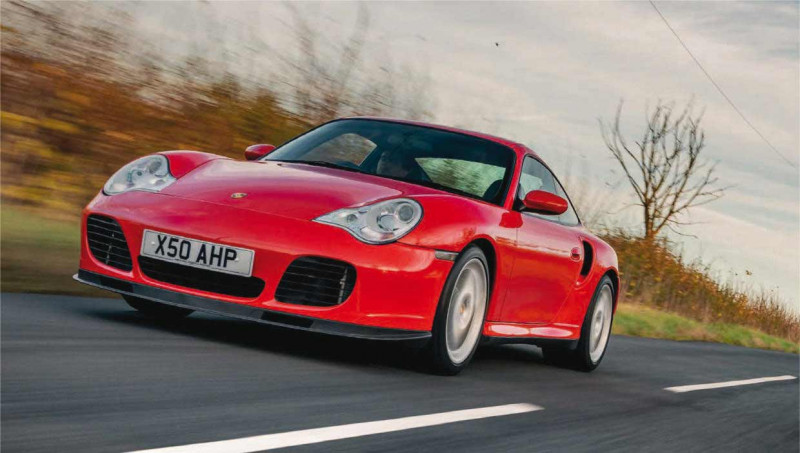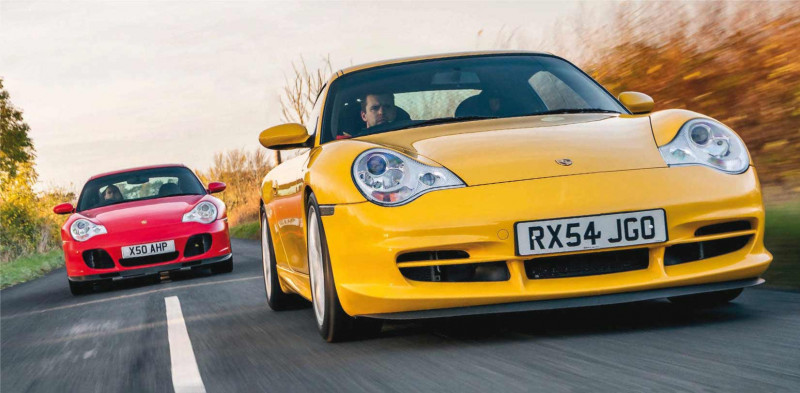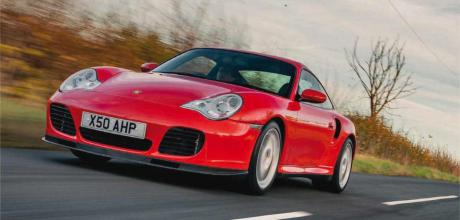25 years of Porsche 911 996
The use of a water-cooled flat-six may have been a radical rethinking of the original 911 concept, but there was much more to the 996 than headlines would have you believe… Words Shane O’Donoghue. Photography Dan Sherwood.
REINVENTING THE STEEL 25 years of Porsche 911 996
There’s more to the 996 than its powerplant.
As we’ve already documented in this celebratory issue of 911 & Porsche World, cost cutting was the name of the game when it came to developing the 996, an approach which found many aspects of the model wanting. Without a determined focus on production spend, however, the 996 — and by extension, the continuation of the 911 bloodline — may never have happened. For this reason, we should embrace Porsche’s decision to share more than a third of components between the 986 Boxster and the 996.


Once the decision had been made to develop the two cars in tandem, a huge amount of effort was expended in the Porsche design department to work out how to share components while giving each model its own identity. Importantly, the 911 needed to look like a 911!
Factory designer, Pinky Lai, is credited with the 996 shape, working under time-served head of Style Porsche, Harm Lagaay. Though many will remember the early 996 for its historically unloved ‘fried egg’ front light clusters, Lai and his colleagues were proud of the fact they did away with the somewhat ugly water drain rail running across the top of the side glass, a feature of all 911s up to and including the 993.
The removal of this detail indicated the 996’s body was brand-new. Indeed, Porsche looked long and hard at using aluminium for the body and even for the chassis, though the material was eventually ruled out on the basis of cost, manufacturing complexity and concerns regarding ease of repair. Instead, a large proportion of high-strength steels were employed (hot zinc-galvanised to protect against corrosion, a method Porsche had pioneered), allowing for weight reduction and a shell claimed to be forty-five percent stiffer in torsion than that of the 993, not to mention fifty percent more resistant to bending forces. The front and rear windscreens were also bonded in for the first time, considerably upping the strength of the structure, which comprised more than sixty-three percent deep-drawn steel, accounting for the smooth, compound curve exterior body panels.
More than twenty-nine percent of the structure was manufactured from high-strength steel, including side-impact protection, the centre tunnel, the windscreen surround and longitudinal frame members. Cleverly, the final heat treatment of these components happened when the paint was baked. The front bulkhead and side sill supports used tailored steel blanks of varying thicknesses, accounting for almost six and a half percent of the overall steel. These were laser-welded together and then pressed to provide strong reinforcement. Last but by no means least, boron steel was used in the footwells and door reinforcements to increase overall strength.
GROWTH OPPORTUNITY
The Euro NCAP organisation was formed in late 1996, in line with increased awareness and demand from car buyers concerned about occupant safety. Though no 911 has ever been subjected to Euro NCAP testing, Porsche was clearly aware of the need to be seen to be focusing on the safety of its customers. This is partly why the 911 grew in size so significantly. To this end, the 996 is 170mm longer than the 993, mostly to allow for larger crumple zones (areas designed to absorb energy in the unfortunate instance of impact). Up front, there’s an alloy subframe — shared with the 986 Boxster — designed to dissipate crash energy into the front chassis legs in the event of a head-on collision. The deformation of the body and structure underneath is then carefully managed to protect the driver and passengers as much as possible.
Porsche made a big deal of its improvements in field of vehicle safety, even coining the POSIP (Porsche Side Impact Protection) acronym. The boron steel door bars were part of this programme of development, which also signalled the addition of new airbags for the driver and passenger. A thorax airbag was integrated into the outer seat bolsters, while a curtain-like airbag was mounted in the doors to protect occupants if a side impact was experienced. This was all standard-fit equipment and was also included in the 996 Cabriolet when launched less than a year after the coupe.
While being safer than ever, the new 911 also had to be more efficient, certainly in terms of fuel economy. Some of the responsibility for realising this ambition lay with the new M96 engine, which we detailed earlier in this magazine, but from the outset, Porsche’s engineers also targeted a lower coefficient of drag for the 996’s body. The smoother surfacing, bonded-in windows and doing away with the old-style water channels helped, of course, as did a more steeply raked windscreen. All things being equal, though, the more ‘slippery’ a car body is through air, the faster the air travels over it relative to air passing underneath. This means more lift due to pressure differential. Even small amounts of lift are undesirable, altering a car’s weight distribution and grip levels by reducing contact pressure on the tyres, leading to instability.
WELCOME INHERITANCE
The bean counters at Porsche looked at doing away with the automatically extending rear spoiler introduced with the arrival of the 964 in 1989, but the 996’s engineers won that particular battle and the idea was carried over to the newer 911. The system was partly responsible for reducing overall lift, while also helping to trim the drag coefficient. This may sound counterintuitive as you picture air slamming into the spoiler and, effectively, slowing the car down, but a key element of drag is rear vacuum, where air detaches from the car body in certain areas, usually at the trailing edge of the roof or bodywork. Within these sections, the car is essentially sucked backwards. A spoiler can negate this effect, or at least alter the strength and position of it. The 996’s rear adornment was also designed to increase cooling airflow to the engine bay when the host 911 was travelling at high speed.
Underneath, Porsche made the floor much smoother than before, helping speed up airflow under the car to the benefit of drag and lift reduction. Where the 993’s coefficient of drag was quoted as 0.32 at best, the 996 managed a creditable 0.3, despite an increase in the frontal area of the car and the use of wider tyres. Ingeniously, the flow of warm air from the front-mounted radiators helped in this regard and was also used to cool the front brakes.
Due to the fact the 996 was designed to deliver high performance from the outset, its anchors had to be uprated to cope with what was likely to be asked of them. Porsche detailed its rudimentary test for resistance to fade, where the driver takes the car to ninety percent of its top speed. Using the 996 Carrera as the obvious example, when equipped with manual transmission, the model tops out at 174mph, meaning a test speed of more than 155mph. The driver then exerts full force on the brakes until slowing to a speed of 62mph. This process is repeated twenty-five times. The test helped define the hardware needed, including 318mm rotors at the front and 299mm items at the rear.
These discs were internally ventilated and featured surface ventilation holes, introduced during the casting process. Brembo supplied the whole brake module to Porsche, though the calipers are manufactured to a Porsche-patented design, taking the form of a single piece of aluminium for improved heat dispersion. The 996 Turbo, incidentally, was the first car to be offered with the now famous Porsche Ceramic Composite Brake (PCCB) option.
The entire front end of the 996 was shared with the 986 Boxster, including its suspension. This configuration was based on the MacPherson strut principle, where the spring surrounds the shock absorber and is clamped between the damper housing and a top mount, which serves as the upper steering pivot. It’s a space-efficient independent suspension design. Porsche further refined it by using conical springs, which take up less room at their ‘pointy’ end and provide a progressive spring rate (in this instance, specific to the 996). In fact, because of the stiffer body and longer wheelbase when compared to the 993, Porsche saw fit to significantly up the stiffness of the front springs and adjust damping in the interests of high-speed driving.
The Stuttgart brand’s engineers used hollow anti-roll bars to further reduce weight and claim to have shaved 140 grams from each strut. The rear suspension was ostensibly little different to that of the 993’s Light- Stable-Agile (LSA) layout. Certainly, the concept was the same, with double wishbones and a sophisticated five-link setup. The detail design was changed significantly, however, to simplify it for production, as much as anything else. For example, the 996’s engineering team managed to reuse the tie-rods and longitudinal arms front and rear, for both the Boxster and the 911. All suspension components were cast in aluminium. At the time of the 996’s launch, Porsche announced the track-correcting arms behind the rear axle allowed for ‘compatible’ toe-in control with the front of the car. During hard cornering, the suspension geometry causes the front wheels to toe-out. To picture what this means, imagine looking down on the car from above. With toe-out, the fronts of both front wheels are turned out, away from each other. Meanwhile, the 996’s rear suspension did the opposite, causing toe-in of the back wheels, where the fronts of the wheels (only slightly) turn towards each other. Porsche claimed this results in better stability and a more natural feel through the steering. Talking of which, the steering system was new, too, with a focus on weight reduction leading to the use of aluminium alloys and even magnesium for the steering column support. The biggest change, however, was the movement of the steering rack to ahead of the front axle line, a first for the 911. Porsche claimed this significantly enhanced steering precision, though in a bid for a better turning circle — in conjunction with a longer wheelbase — the number of turns of the steering wheel had to increase from lock to lock. Even so, a 1.1-metre turning circle was of huge benefit for everyday driving.
NEW DAY RISING
As alluded to throughout this examination of the 996, production efficiency was front and centre in every decision made during creation of the new 911. Not only were some thirty-six percent of the car’s parts shared with the 986 Boxster, Porsche completely reinvented its manufacturing technique in Zuffenhausen, adopting the ‘just-in-time’ method first developed in Japan by Toyota. In this approach, instead of having warehouses full of parts ready for assembly, the arrival of the components from suppliers is timed precisely to coincide with when they’re required for installation at each technician’s workstation. To make this practice work effectively, suppliers are involved early on in each new car project, primarily because they’re commissioned not only to supply individual components, but also full assemblies, greatly speeding up manufacturing of the final car. For example, the 996’s front and rear axles were supplied fully built, with dampers, track control arms, tie-rods, anti-roll bars and subframes already bolted together. The same was true of the model’s dashboard, which was provided complete with instrumentation, switchgear, heating, ventilation and air conditioning systems.
The result of all this effort was a reduction in the manufacturing time for a 911 of almost twenty percent in comparison to how long it took to complete the build of a 993. Tellingly, when publishing its promotional press release for the 996, Porsche stated “this allows us to maintain production facilities in Germany.” These few words say a great deal, perhaps underscoring just how important an overhaul of the Zuffenhausen production lines were in securing the survival of the 911 and, moreover, Porsche as a manufacturer.
Above The low purchase price of a 996 Carrera makes it the perfect modern 911 for personalization. Above It’s no accident how a high number of marque specialists use a 996 as their everyday Porsche.
Above The standard Carrera might look a little tame when parked next to a Turbo or GT3, but fit a considered set of wheels and a few subtle body updates and a base model suddenly pops just as much as the exotic models in the 996 line.
Above Get past gripes about ‘fried egg’ headlights and exaggerated claims regarding the volume of problematic M96 engines and you’ll find the 996 to be a hugely rewarding 911.
THE AXLES WERE SUPPLIED FULLY BUILT, WITH DAMPERS, TRACK CONTROL ARMS, TIE RODS, ANTI-ROLL BARS AND SUBFRAMES ALREADY BOLTED TOGETHER
PORSCHE DETAILED ITS RUDIMENTARY TEST FOR RESISTANCE TO FADE, WHERE THE DRIVER TAKES THE CAR TO NINETY PERCENT OF ITS TOP SPEED


